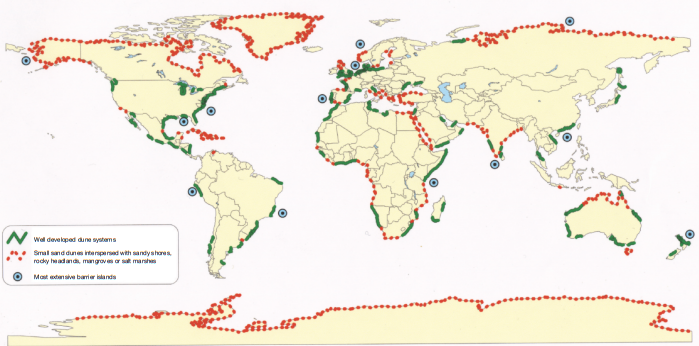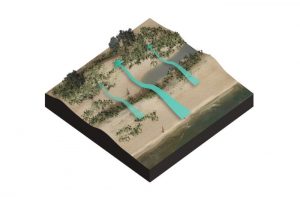Overview
Naturally, a coastal dune system is a dynamic system. However, often dune systems have been stabilized to provide more (conceived) reliable coastal defense. We define ‘dune dynamics’ as the movement of sand into and within the dune system. Depending on the functions that the dune system fulfills and its current state, the enhancement of dune dynamics can be considered. Enhancing dynamics in coastal dunes fits with the philosophy of Building with Nature. If applied under the right circumstances, these natural processes can be used as a strategy to enhance flood safety, enable habitat conservation/development, and improve spatial quality.
Coastal dunes function as sandy flood defenses: they are natural barriers that protect the hinterland from coastal flooding. Dune systems are present in many locations all over the world (Figure 1, Martinez et al., 2008 and Raffaele & Bruno, 2019).

Dune systems are important multifunctional landscapes, that do not only function as flood defense, but also provide habitats for flora and fauna, serve as recreational areas and facilitate drinking water provision (Moulis and Barbel, 1999). Depending on these functions and on the functions that are envisioned for the dune system you either want to enhance or prevent the movement of sand into and within the dune system. For example in a dune system that is stabilized, and in which natural values are deteriorating, enhancement of the movement of sand can be a strategy to improve the natural values. Whereas in a small dune system with people living in or directly behind the dunes the transportation of sand is inhibited to prevent nuisance.
This concept discusses the boundary conditions and the benefits of enhancement of dune dynamics depending on the specific functions of the dune system. It focusses on coastal dunes in temperate climates. For more information on coastal dunes in the tropics we refer to Hesp (2008).
We distinguish two situations: 1) existing coastal dunes and 2) the design of ‘new’ coastal dunes (dune reconstruction). This concept presents strategies to deal with dynamics in both situations. In the sections below you find the following information:
- Get started: a theoretical framework on dune dynamics. The section gives an introduction on physical and ecological process in a coastal dune system and presents morphological elements that reflect dune dynamics in the system. The section ends with an overview of the boundary conditions and the benefits of enhancing dune dynamics.
- How to use: a guide for enhancing dune dynamics in the situation of existing coastal dunes and the design of ‘new’ coastal dunes (dune reconstruction).
- Practical applications: examples of projects where enhancing or controlling dune dynamics was one of the objectives.

